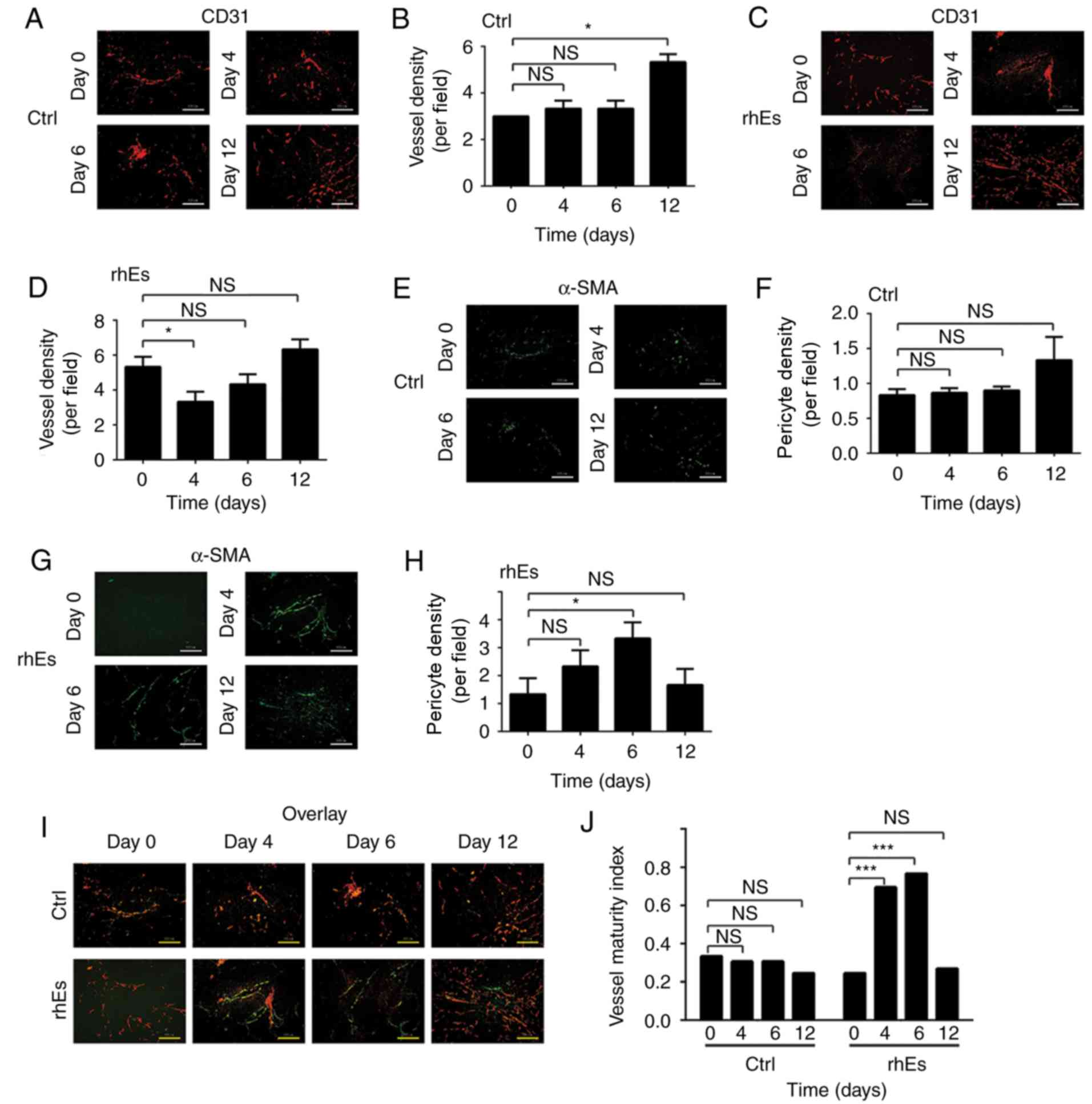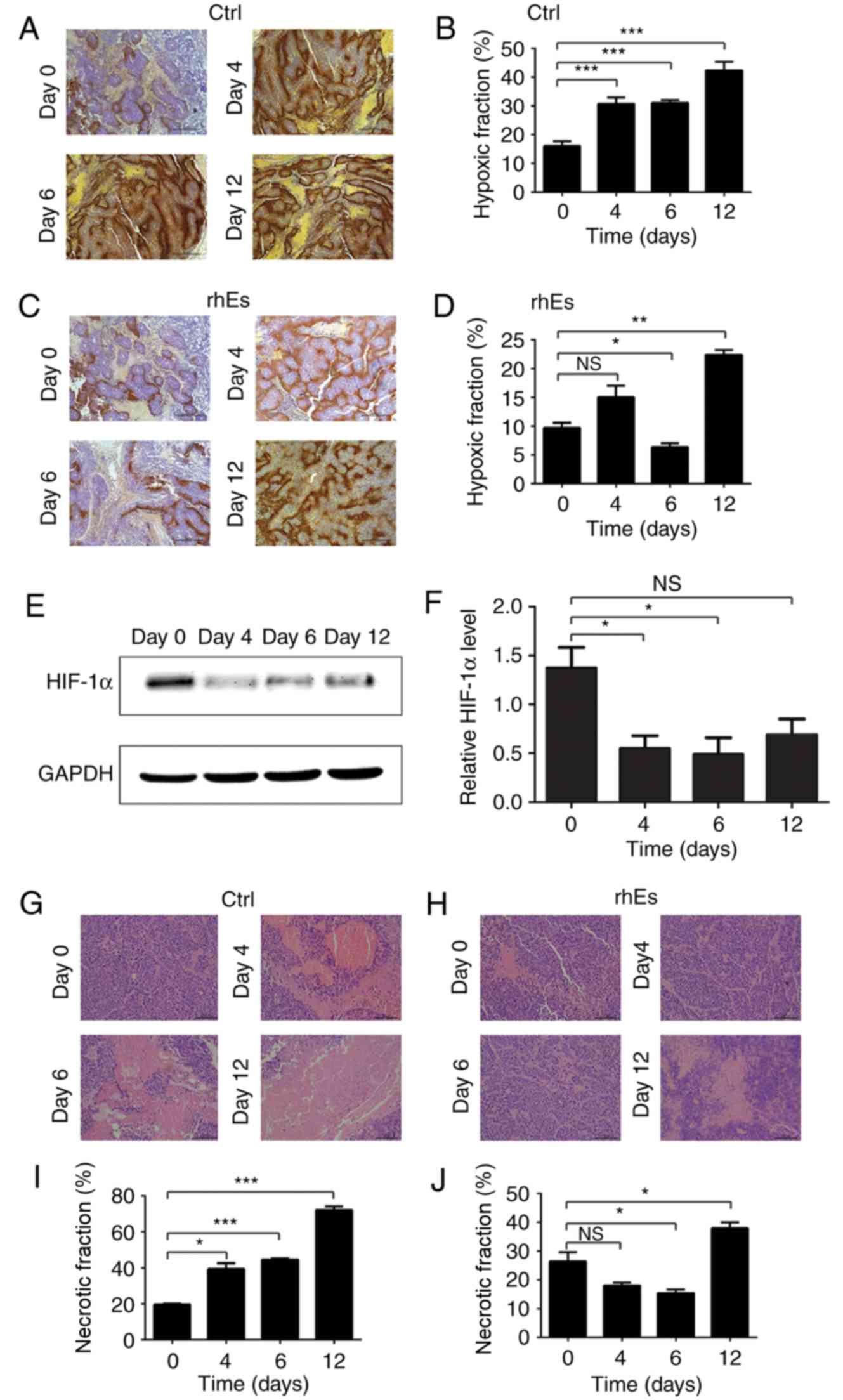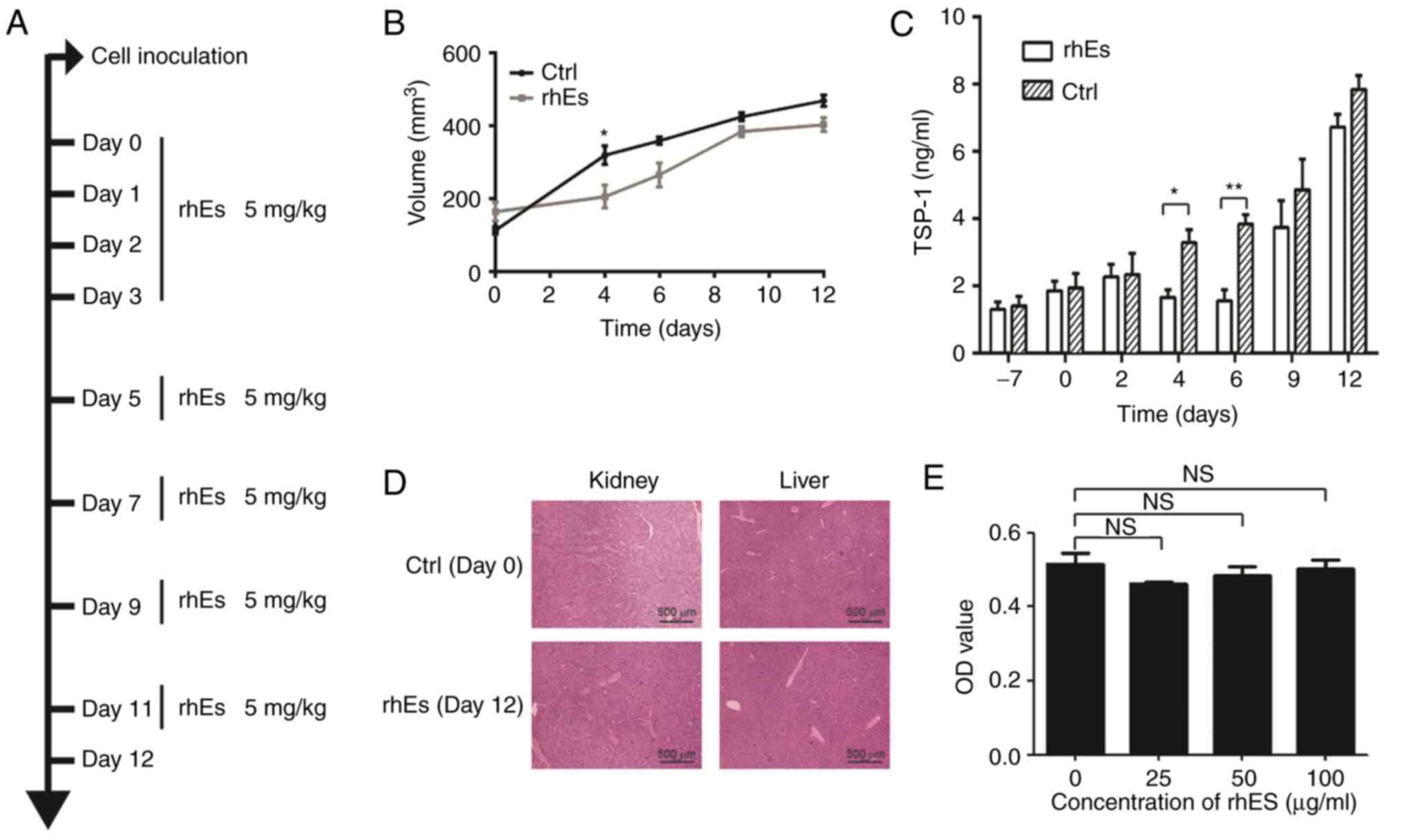|
1
|
Folkman J: Tumor angiogenesis: Therapeutic
implications. N Engl J Med. 285:1182–1186. 1971. View Article : Google Scholar : PubMed/NCBI
|
|
2
|
Rupaimoole R, Ivan C, Yang D, Gharpure KM,
Wu SY, Pecot CV, Previs RA, Nagaraja AS, Armaiz-Pena GN, McGuire M,
et al: Hypoxia-upregulated microRNA-630 targets Dicer, leading to
increased tumor progression. Oncogene. 35:4312–4320. 2016.
View Article : Google Scholar : PubMed/NCBI
|
|
3
|
Adapala RK, Thoppil RJ, Ghosh K, Cappelli
HC, Dudley AC, Paruchuri S, Keshamouni V, Klagsbrun M, Meszaros JG,
Chilian WM, et al: Activation of mechanosensitive ion channel TRPV4
normalizes tumor vasculature and improves cancer therapy. Oncogene.
35:314–322. 2016. View Article : Google Scholar : PubMed/NCBI
|
|
4
|
Shin DH, Choi YJ and Park JW: SIRT1 and
AMPK mediate hypoxia-induced resistance of non-small cell lung
cancers to cisplatin and doxorubicin. Cancer Res. 74:298–308. 2014.
View Article : Google Scholar : PubMed/NCBI
|
|
5
|
Sen A, Capitano ML, Spernyak JA,
Schueckler JT, Thomas S, Singh AK, Evans SS, Hylander BL and
Repasky EA: Mild elevation of body temperature reduces tumor
interstitial fluid pressure and hypoxia and enhances efficacy of
radiotherapy in murine tumor models. Cancer Res. 71:3872–3880.
2011. View Article : Google Scholar : PubMed/NCBI
|
|
6
|
Ashton TM, Fokas E, Kunz-Schughart LA,
Folkes LK, Anbalagan S, Huether M, Kelly CJ, Pirovano G, Buffa FM,
Hammond EM, et al: The anti-malarial atovaquone increases
radiosensitivity by alleviating tumour hypoxia. Nat Commun.
7:123082016. View Article : Google Scholar : PubMed/NCBI
|
|
7
|
Meijer TW, Kaanders JH, Span PN and
Bussink J: Targeting hypoxia, HIF-1, and tumor glucose metabolism
to improve radiotherapy efficacy. Clin Cancer Res. 18:5585–5594.
2012. View Article : Google Scholar : PubMed/NCBI
|
|
8
|
Zhang HM, Ren Y, Tang XJ, Wang K, Liu Y,
Zhang L, Li X, Liu P, Zhao C and He J: Vascular normalization
induced by sinomenine hydrochloride results in suppressed mammary
tumor growth and metastasis. Sci Rep. 5:88882015. View Article : Google Scholar : PubMed/NCBI
|
|
9
|
Jain RK: Normalizing tumor vasculature
with anti-angiogenic therapy: A new paradigm for combination
therapy. Nat Med. 7:987–989. 2001. View Article : Google Scholar : PubMed/NCBI
|
|
10
|
Chatterjee S, Wieczorek C, Schöttle J,
Siobal M, Hinze Y, Franz T, Florin A, Adamczak J, Heukamp LC,
Neumaier B and Ullrich RT: Transient antiangiogenic treatment
improves delivery of cytotoxic compounds and therapeutic outcome in
lung cancer. Cancer Res. 74:2816–2824. 2014. View Article : Google Scholar : PubMed/NCBI
|
|
11
|
Ader I, Gstalder C, Bouquerel P, Golzio M,
Andrieu G, Zalvidea S, Richard S, Sabbadini RA, Malavaud B and
Cuvillier O: Neutralizing S1P inhibits intratumoral hypoxia,
induces vascular remodelling and sensitizes to chemotherapy in
prostate cancer. Oncotarget. 6:13803–13821. 2015. View Article : Google Scholar : PubMed/NCBI
|
|
12
|
Goel S, Duda DG, Xu L, Munn LL, Boucher Y,
Fukumura D and Jain RK: Normalization of the vasculature for
treatment of cancer and other diseases. Physiol Rev. 91:1071–1121.
2011. View Article : Google Scholar : PubMed/NCBI
|
|
13
|
Schneider BP, Wang M, Radovich M, Sledge
GW, Badve S, Thor A, Flockhart DA, Hancock B, Davidson N, Gralow J,
et al: Association of vascular endothelial growth factor and
vascular endothelial growth factor receptor-2 genetic polymorphisms
with outcome in a trial of paclitaxel compared with paclitaxel plus
bevacizumab in advanced breast cancer: ECOG 2100. J Clin Oncol.
26:4672–4678. 2008. View Article : Google Scholar : PubMed/NCBI
|
|
14
|
Schneider Duda DG, Willett CG, Ancukiewicz
M, di Tomaso E, Shah M, Czito BG, Bentley R, Poleski M, Lauwers GY,
Carroll M, et al: Plasma soluble VEGFR-1 is a potential dual
biomarker of response and toxicity for bevacizumab with
chemoradiation in locally advanced rectal cancer. Oncologist.
15:577–583. 2010. View Article : Google Scholar : PubMed/NCBI
|
|
15
|
Lassau N, Coiffier B, Kind M, Vilgrain V,
Lacroix J, Cuinet M, Taieb S, Aziza R, Sarran A, Labbe-Devilliers
C, et al: Selection of an early biomarker for vascular
normalization using dynamic contrast-enhanced ultrasonography to
predict outcomes of metastatic patients treated with bevacizumab.
Ann Oncol. 27:1922–1928. 2016. View Article : Google Scholar : PubMed/NCBI
|
|
16
|
Good DJ, Polverini PJ, Rastinejad F, Le
Beau MM, Lemons RS, Frazier WA and Bouck NP: A tumor
suppressor-dependent inhibitor of angiogenesis is immunologically
and functionally indistinguishable from a fragment of
thrombospondin. Proc Natl Acad Sci USA. 87:6624–6628. 1990.
View Article : Google Scholar : PubMed/NCBI
|
|
17
|
Takahashi K, Sumarriva K, Kim R, Jiang R,
Brantley-Sieders DM, Chen J, Mernaugh RL and Takahashi T:
Determination of the CD148-interacting region in thrombospondin-1.
PLoS One. 11:e01549162016. View Article : Google Scholar : PubMed/NCBI
|
|
18
|
Hamano Y, Sugimoto H, Soubasakos MA,
Kieran M, Olsen BR, Lawler J, Sudhakar A and Kalluri R:
Thrombospondin-1 associated with tumor microenvironment contributes
to low-dose cyclophosphamide-mediated endothelial cell apoptosis
and tumor growth suppression. Cancer Res. 64:1570–1574. 2004.
View Article : Google Scholar : PubMed/NCBI
|
|
19
|
Bocci G, Francia G, Man S, Lawler J and
Kerbel RS: Thrombospondin 1, a mediator of the antiangiogenic
effects of low-dose metronomic chemotherapy. Proc Natl Acad Sci
USA. 100:12917–12922. 2003. View Article : Google Scholar : PubMed/NCBI
|
|
20
|
Firlej V, Mathieu JR, Gilbert C, Lemonnier
L, Nakhlé J, Gallou-Kabani C, Guarmit B, Morin A, Prevarskaya N,
Delongchamps NB and Cabon F: Thrombospondin-1 triggers cell
migration and development of advanced prostate tumors. Cancer Res.
71:7649–7658. 2011. View Article : Google Scholar : PubMed/NCBI
|
|
21
|
Ohta M, Kawabata T, Yamamoto M, Tanaka T,
Kikuchi H, Hiramatsu Y, Kamiya K, Baba M and Konno H: TSU68, an
antiangiogenic receptor tyrosine kinase inhibitor, induces tumor
vascular normalization in a human cancer xenograft nude mouse
model. Surg Today. 39:1046–1053. 2009. View Article : Google Scholar : PubMed/NCBI
|
|
22
|
Meng MB, Zaorsky NG, Deng L, Wang HH, Chao
J, Zhao LJ, Yuan ZY and Ping W: Pericytes: Adouble-edged sword in
cancer therapy. Future Oncol. 11:169–179. 2015. View Article : Google Scholar : PubMed/NCBI
|
|
23
|
Gaustad JV, Simonsen TG, Andersen LM and
Rofstad EK: Thrombospondin-1 domain-containing peptide
properdistatin improves vascular function in human melanoma
xenografts. Microvasc Res. 98:159–165. 2015. View Article : Google Scholar : PubMed/NCBI
|
|
24
|
Dawes J, Clemetson KJ, Gogstad GO,
McGregor J, Clezardin P, Prowse CV and Pepper DS: A
radioimmunoassay for thrombospondin, used in a comparative study of
thrombospondin, beta-thromboglobulin and platelet factor 4 in
healthy volunteers. Thromb Res. 29:569–581. 1983. View Article : Google Scholar : PubMed/NCBI
|
|
25
|
Phelan MW, Forman LW, Perrine SP and
Faller DV: Hypoxia increases thrombospondin-1 transcript and
protein in cultured endothelial cells. J Lab Clin Med. 132:519–529.
1998. View Article : Google Scholar : PubMed/NCBI
|
|
26
|
Jain RK: Normalization of tumor
vasculature: An emerging concept in antiangiogenic therapy.
Science. 307:58–62. 2005. View Article : Google Scholar : PubMed/NCBI
|
|
27
|
Giantonio BJ, Catalano PJ, Meropol NJ,
O'Dwyer PJ, Mitchell EP, Alberts SR, Schwartz MA and Benson AB III;
Eastern Cooperative Oncology Group Study E3200, : Bevacizumab in
combination with oxaliplatin, fluorouracil, and leucovorin
(FOLFOX4) for previously treated metastatic colorectal cancer:
Results from the Eastern cooperative oncology group study E3200. J
Clin Oncol. 25:1539–1544. 2007. View Article : Google Scholar : PubMed/NCBI
|
|
28
|
Browder T, Butterfield CE, Kräling BM, Shi
B, Marshall B, O'Reilly MS and Folkman J: Antiangiogenic scheduling
of chemotherapy improves efficacy against experimental
drug-resistant cancer. Cancer Res. 60:1878–1886. 2000.PubMed/NCBI
|
|
29
|
Segers J, Di Fazio V, Ansiaux R, Martinive
P, Feron O, Wallemacq P and Gallez B: Potentiation of
cyclophosphamide chemotherapy using the anti-angiogenic drug
thalidomide: Importance of optimal scheduling to exploit the
‘normalization’ window of the tumor vasculature. Cancer Lett.
244:129–135. 2006. View Article : Google Scholar : PubMed/NCBI
|
|
30
|
Dickson PV, Hamner JB, Sims TL, Fraga CH,
Ng CY, Rajasekeran S, Hagedorn NL, McCarville MB, Stewart CF and
Davidoff AM: Bevacizumab-induced transient remodeling of the
vasculature in neuroblastoma xenografts results in improved
delivery and efficacy of systemically administered chemotherapy.
Clin Cancer Res. 13:3942–3950. 2007. View Article : Google Scholar : PubMed/NCBI
|
|
31
|
Jain RK, Duda DG, Willett CG, Sahani DV,
Zhu AX, Loeffler JS, Batchelor TT and Sorensen AG: Biomarkers of
response and resistance to antiangiogenic therapy. Nat Rev Clin
Oncol. 6:327–338. 2009. View Article : Google Scholar : PubMed/NCBI
|
|
32
|
Facciabene A, Peng XH, Hagemann IS, Balint
K, Barchetti A, Wang LP, Gimotty PA, Gilks CB, Lal P, Zhang L and
Coukos G: Tumour hypoxia promotes tolerance and angiogenesis via
CCL28 and T-(reg) cells. Nature. 475:226–230. 2011. View Article : Google Scholar : PubMed/NCBI
|
|
33
|
Chouaib S, Messai Y, Couve S, Escudier B,
Hasmim M and Noman MZ: Hypoxia promotes tumor growth in linking
angiogenesis to immune escape. Front Immunol. 3:212012. View Article : Google Scholar : PubMed/NCBI
|
|
34
|
Jia Y, Liu M, Huang W, Wang Z, He Y, Wu J,
Ren S, Ju Y, Geng R and Li Z: Recombinant human endostatin endostar
inhibits tumor growth and metastasis in a mouse xenograft model of
colon cancer. Pathol Oncol Res. 18:315–323. 2012. View Article : Google Scholar : PubMed/NCBI
|
|
35
|
Sorensen AG, Batchelor TT, Zhang WT, Chen
PJ, Yeo P, Wang MY, Jennings D, Wen PY, Lahdenranta J, Ancukiewicz
M, et al: A ‘Vascular Normalization Index’ as potential mechanistic
biomarker to predict survival after a single dose of cediranib in
recurrent glioblastoma patients. Cancer Res. 69:5296–5300. 2009.
View Article : Google Scholar : PubMed/NCBI
|

















